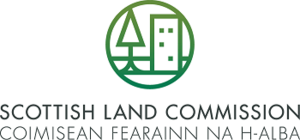Scottish Land Commission facts for kids
| Scottish Gaelic: Coimisean Fearainn na h-Alba | |

Scottish Land Commission logo
|
|
| Agency overview | |
|---|---|
| Formed | 1 April 2017 |
| Type | Executive non-departmental public body |
| Jurisdiction | Scotland |
| Headquarters | An Lòchran, 10 Inverness Campus, Inverness, IV2 5NA 57°29′15″N 4°13′36″W / 57.4876°N 4.2267°W |
| Agency executives |
|
| Parent department | Scottish Government |
| Key document | |
| Map | |

Scotland in the UK and Europe
|
|
The Scottish Land Commission (which is Coimisean Fearainn na h-Alba in Scottish Gaelic) is an important group in Scotland. It was set up by the Scottish Government in 2017. This happened after a new law called the Land Reform (Scotland) Act 2016 was passed by the Scottish Parliament.
The main job of the Commission is to look at how land in Scotland is owned, used, and managed. They want to make sure land is used fairly and helps everyone. The Commission also includes a special role called the Tenant Farming Commissioner. This person works to make relationships better between farmers who rent land (tenant farmers) and the people who own that land (landowners). They create helpful guides and rules to make things run smoothly.
Contents
Why the Scottish Land Commission Was Created
The Scottish Land Commission was formed to help improve how land is used and owned in Scotland. They look at big questions like who owns a lot of land and how land can be used to benefit everyone. They also check if laws about land are working well.
Looking at Land Ownership and Use
In 2013, a Scottish government minister named Richard Lochhead started a review. This review looked closely at how land was owned and used in Scotland. It also examined the relationships between landowners and tenant farmers. The review's final report came out in 2015.
The report said that good relationships between landowners and farmers were very important for farming in Scotland. It suggested that trust and respect were key for everyone involved.
The Land Reform Act of 2016
After the review, the Scottish Government created a new law. This law was called the Land Reform (Scotland) Bill. It was presented to the Scottish Parliament in June 2015. The Parliament approved the law in March 2016. It then became the Land Reform (Scotland) Act 2016. This Act is the main reason the Scottish Land Commission exists.
Some people had concerns about the new law. They worried that too many details would be decided later by ministers, rather than being clearly written in the law itself. Others, like Scottish Land and Estates (a group representing landowners), felt the law didn't fully appreciate the good work landowners do. However, the government said the law was about making things fair for everyone. They wanted to encourage good ways of working together across Scotland.
Some groups, like the Scottish Green Party, felt the law didn't go far enough. They wanted stricter rules, for example, about who could own land in Scotland. They were also disappointed that the law didn't limit how much land one person could own.
Where the Commission Works
The Scottish Land Commission has its main office in An Lòchran, Inverness. About twenty people work there. This includes five Land Commissioners, the Tenant Farming Commissioner, and other support staff. The chief executive officer, who leads the staff, is Hamish Trench. He has a lot of experience with land and national parks.
Who Are the Commissioners?
The Commissioners are the people who lead the Scottish Land Commission. They are chosen carefully to make sure they can do their job well.
Choosing the Commissioners
The first Commissioners were suggested in November 2016. These included Andrew Thin, Professor David Adams, Lorne MacLeod, Sally Reynolds, Megan MacInnes, and Bob McIntosh. Bob McIntosh was chosen to be the Tenant Farming Commissioner.
The Scottish Parliament's Environment, Climate Change, and Land Reform Committee looked at these suggestions. They recommended that Parliament approve the appointments. They also suggested that Bob McIntosh should leave his membership of a surveying group to make sure he seemed completely fair to everyone. They also asked another Commissioner, Lorne MacLeod, to step down from some other roles to avoid any conflicts of interest. The Scottish Parliament approved the appointments in December 2016.
The Chairman of the Commission
The first chairman of the Scottish Land Commission was Andrew Thin. He had previously advised the Scottish Government on tenant farming. He also helped set up the Cairngorms National Park Authority.
The Tenant Farming Commissioner's Role
The Tenant Farming Commissioner has a very specific job. This person cannot be a landowner or a tenant farmer themselves. Their main goal is to create clear rules and guides (called codes of practice) to help landowners and tenant farmers work together. These rules are in addition to existing laws.
The Tenant Farming Commissioner can also investigate if these rules are not followed. Both landowners and tenant farmers supported the idea of having this role. There had been problems in the past where relationships between them were difficult. The Commissioner hopes that these new rules will help people solve problems without needing to go to court. If someone has a formal complaint, the Commissioner can investigate it.

